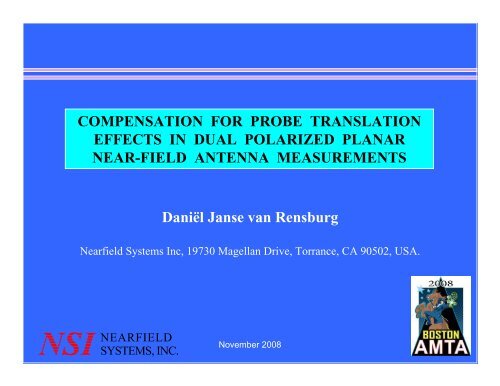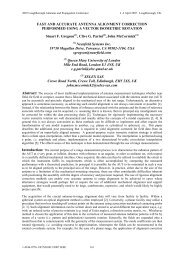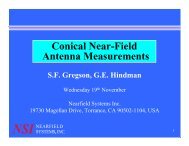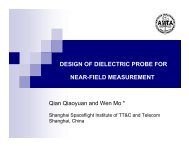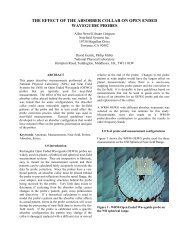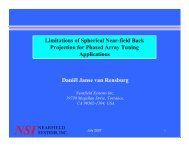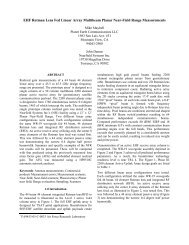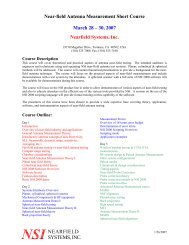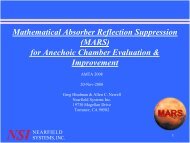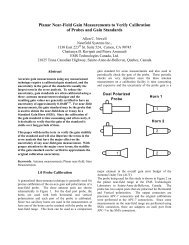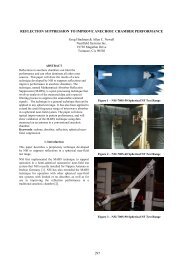Create successful ePaper yourself
Turn your PDF publications into a flip-book with our unique Google optimized e-Paper software.
COMPENSATION FOR PROBE TRANSLATION<br />
EFFECTS IN DUAL POLARIZED PLANAR<br />
NEAR-FIELD ANTENNA MEASUREMENTS<br />
Daniël Janse van Rensburg<br />
<strong>Nearfield</strong> <strong>Systems</strong> <strong>Inc</strong>, 19730 Magellan Drive, Torrance, CA 90502, USA.<br />
November 2008 1
Overview<br />
• Planar near-field acquisition<br />
• Probe translation & compensation formulation<br />
• Example 1<br />
• Offset determination<br />
• Example 2<br />
• Conclusions<br />
November 2008 2
Probe Translation Problem<br />
Cable.<br />
y<br />
Pol = 90 degrees.<br />
x<br />
z<br />
x<br />
y<br />
Cable.<br />
Pol = 0 degrees.<br />
November 2008 3
Planar Near-field Scan<br />
November 2008 4
' K P<br />
( P = a F ∫ e<br />
i ⋅<br />
0<br />
S 02 ⋅<br />
'<br />
0<br />
)<br />
PNF Spectral Relations I<br />
'<br />
( ) ( )<br />
iγd<br />
K S10<br />
K e d K<br />
Kerns’ representation of the complex measured voltage on a planar<br />
surface to the AUT plane wave spectral function, where<br />
P = Vector<br />
K = Transverse<br />
b<br />
a<br />
'<br />
0<br />
0<br />
F'<br />
= Mismatch<br />
e<br />
S<br />
'<br />
02<br />
= Complex<br />
= Complex<br />
e<br />
i K • P iγd<br />
relative<br />
= Probe<br />
defining<br />
to<br />
input<br />
= Phase<br />
scan<br />
part<br />
measured<br />
term<br />
near −<br />
of<br />
signal.<br />
signal.<br />
correction term.<br />
relating<br />
probe location.<br />
field<br />
plane centre.<br />
AUT<br />
plane wave spectrum.<br />
probe<br />
location<br />
propagation vector k.<br />
origin<br />
to<br />
Probe spectrum<br />
S<br />
10<br />
=<br />
AUT<br />
plane<br />
wave<br />
spectrum.<br />
November 2008 5
Probe Translation Problem<br />
Cable.<br />
y<br />
Pol = 90 degrees.<br />
x<br />
z<br />
x<br />
y<br />
Cable.<br />
Pol = 0 degrees.<br />
November 2008 6
PNF Spectral Relations II<br />
In order to solve for the complex spectrum of the AUT, two measurement data sets<br />
are required using two near-field probes that have linearly independent spectra,<br />
leading to a set of two equations with two unknowns.<br />
If the equation shown above is regarded as the first data set, the second (after probe<br />
polarization rotation) can be written as<br />
b<br />
'' K P T<br />
P a F e<br />
i ( )<br />
( = ∫<br />
⋅ +<br />
0<br />
S 02 ⋅<br />
''<br />
0<br />
)<br />
''<br />
( ) ( )<br />
iγd<br />
K S10<br />
K e d K<br />
T<br />
b<br />
S<br />
''<br />
0<br />
= Δxxˆ<br />
+ Δyyˆ<br />
''<br />
02<br />
=<br />
Complex<br />
=<br />
Rotated<br />
= Vector defining rotated probe translation.<br />
measured signal for rotated probe.<br />
probe plane wave spectrum.<br />
November 2008 7
Example I: 94 GHz CP Horn<br />
Case #<br />
Δx [mm]<br />
Δx [λ]<br />
Δy[mm]<br />
Δy[λ]<br />
1<br />
Example I: 94 GHz CP Horn<br />
Y (meters)<br />
-0.45<br />
-0.50<br />
-0.55<br />
-0.60<br />
-0.65<br />
0<br />
-2<br />
-4<br />
-6<br />
-8<br />
-10<br />
-12<br />
-14<br />
-16<br />
-18<br />
-20<br />
-22<br />
-24<br />
-26<br />
-28<br />
-30<br />
-32<br />
-34<br />
-36<br />
-38<br />
-40<br />
-42<br />
-44<br />
-46<br />
-48<br />
-50<br />
Y (meters)<br />
-0.45<br />
-0.50<br />
-0.55<br />
-0.60<br />
-0.65<br />
0<br />
-2<br />
-4<br />
-6<br />
-8<br />
-10<br />
-12<br />
-14<br />
-16<br />
-18<br />
-20<br />
-22<br />
-24<br />
-26<br />
-28<br />
-30<br />
-32<br />
-34<br />
-36<br />
-38<br />
-40<br />
-42<br />
-44<br />
-46<br />
-48<br />
-50<br />
-0.70<br />
-0.70<br />
-0.15 -0.10 -0.05 0.00 0.05 0.10<br />
X (meters)<br />
-0.15 -0.10 -0.05 0.00 0.05 0.10<br />
X (meters)<br />
Near-field intensity for CP antenna measured with LP<br />
probe. Δx = 4mm (1.25λ) and Δy = -4.5mm (1.4λ).<br />
Dynamic range shown is 50 dB.<br />
November 2008 9
Example I: 94 GHz CP Horn<br />
0<br />
Uncorrected Corrected Reference<br />
0<br />
Uncorrected Corrected Reference<br />
-5<br />
-5<br />
-10<br />
-10<br />
Amplitude (dB)<br />
-15<br />
-20<br />
-25<br />
Amplitude (dB)<br />
-15<br />
-20<br />
-25<br />
-30<br />
-30<br />
-35<br />
-35<br />
-40<br />
-40 -30 -20 -10 0 10 20 30 40<br />
Elevation (deg)<br />
-40<br />
-40 -30 -20 -10 0 10 20 30 40<br />
Elevation (deg)<br />
Elevation plane co-polarized (left) and cross-polarized (right)<br />
patterns for 94 GHz CP horn. Case #2 uncorrected data (red),<br />
Case #2 corrected (blue) and Case 1 reference data (purple).<br />
T = 4mm (x) – 4.5mm (y).<br />
November 2008 10
Example I: 94 GHz CP Horn<br />
Far-field amplitude of test_c_11.nsi<br />
Far-field amplitude of test_c_10.nsi<br />
0<br />
0.5 mm 1.5 mm 2.5 mm 3.5 mm 4.5 mm<br />
0<br />
7.5 mm 8.5 mm 9.5 mm 10.5 mm 11.5 mm 12.5 mm<br />
-5<br />
-5<br />
-10<br />
-10<br />
-15<br />
-15<br />
Amplitude (dB)<br />
-20<br />
-25<br />
Amplitude (dB)<br />
-20<br />
-25<br />
-30<br />
-30<br />
-35<br />
-35<br />
-40<br />
-40<br />
-40 -30 -20 -10 0 10 20 30 40 -40 -30 -20 -10 0 10 20 30 40<br />
Elevation (deg)<br />
Elevation (deg)<br />
Sensitivity examples for a 1.5λ translation.<br />
Case #2 (left) Case #3 (right).<br />
November 2008 11
Automated Probe Offset Determination<br />
1. Full near-field acquisition with the near-field probe<br />
polarization positions 0° and 90°.<br />
‣ Extract far-field phase data for horizontal (azimuth)<br />
and vertical (elevation) planes.<br />
2. Repeat near-field acquisition with the near-field<br />
probe polarization positions 180° and 270°.<br />
‣ Extract far-field phase data for horizontal (azimuth)<br />
and vertical (elevation) planes.<br />
Cable.<br />
Pol = 90 degrees.<br />
y<br />
3. Subtraction of the two far-field phase reference<br />
patterns is a direct measure of the probe translation<br />
Δx & Δy.<br />
x<br />
x<br />
z<br />
y<br />
Cable.<br />
Pol = 0 degrees.<br />
November 2008 12
Example 2: 23 GHz LP Array<br />
Near-field amplitude of DJvR_Probe_offset01.nsi<br />
0.25<br />
Y (meters)<br />
0.20<br />
0.15<br />
0.10<br />
0.05<br />
0.00<br />
-0.05<br />
-0.10<br />
-0.15<br />
-0.20<br />
0<br />
-2<br />
-4<br />
-6<br />
-8<br />
-10<br />
-12<br />
-14<br />
-16<br />
-18<br />
-20<br />
-22<br />
-24<br />
-26<br />
-28<br />
-30<br />
-32<br />
-34<br />
-36<br />
-38<br />
-40<br />
-42<br />
-44<br />
-46<br />
-48<br />
-50<br />
-0.25<br />
-0.25 -0.20 -0.15 -0.10 -0.05 0.00 0.05 0.10 0.15 0.20 0.25<br />
X (meters)<br />
Near-field intensity for LP slotted waveguide array<br />
measured with LP probe (orthogonal polarization<br />
component is not shown since amplitude < -50 dB ).<br />
Δx = Δy = 3mm (0.23λ at 23.25 GHz). Dynamic<br />
range shown is 50 dB.<br />
November 2008 13
Example 2: 23 GHz LP Array<br />
0<br />
Far-field amplitude of DJvR_Probe_offset01.nsi<br />
0/90 Case 180/270 Case<br />
Far-field phase of DJvR_Probe_offset01.nsi - Far-field phase of DJvR_Probe_offset04.nsi<br />
0/90 Case 180/270 Case Phase difference<br />
-5<br />
150<br />
-10<br />
-15<br />
100<br />
Amplitude (dB)<br />
-20<br />
-25<br />
-30<br />
-35<br />
-40<br />
Phase (deg)<br />
50<br />
0<br />
-50<br />
-100<br />
-45<br />
-50<br />
-50 -40 -30 -20 -10 0 10 20 30 40 50<br />
Azimuth (deg)<br />
-150<br />
-30 -20 -10 0 10 20 30<br />
Azimuth (deg)<br />
Azimuth LP co-polarized anplitude (left) and phase (right) patterns. Probe position<br />
0/90 data (red) and probe position 180/270 (blue). Phase data comparison showing<br />
the 3 mm probe translation effect. The difference between the two phase functions<br />
is also shown and is sinusoidal with respect to the azimuth angle.<br />
November 2008 14
Example 2: 23 GHz LP Array<br />
5.0<br />
Average<br />
The difference between the two phase functions can be<br />
converted to a linear offset Δx using<br />
Probe Offset<br />
Probe x offset<br />
Δx<br />
=<br />
λΔPhase<br />
2π<br />
sinθ<br />
Linear distance [mm]<br />
4.5<br />
4.0<br />
3.5<br />
3.0<br />
2.5<br />
2.0<br />
1.5<br />
1.0<br />
0.5<br />
0.0<br />
-30 -20 -10 0 10 20 30<br />
Azimuth (deg)<br />
Since we know the offset has to be<br />
> 0 and < 5 mm, the average value<br />
of all values in this domain can be<br />
calculated. It follows that:<br />
Δx = (2.98 mm).<br />
Repeating this process for the<br />
elevation plane it follows that:<br />
Δy = (3.04 mm).<br />
November 2008 15
Example 2: 23 GHz LP Array<br />
Far-field phase of NewFilename.nsi<br />
Uncorrected Corrected Reference<br />
Far-field phase of NewFilename.nsi<br />
Uncorrected Corrected Reference<br />
150<br />
150<br />
100<br />
100<br />
50<br />
50<br />
Phase (deg)<br />
0<br />
Phase (deg)<br />
0<br />
-50<br />
-50<br />
-100<br />
-100<br />
-150<br />
-150<br />
-30 -20 -10 0 10 20 30<br />
Azimuth (deg)<br />
-30 -20 -10 0 10 20 30<br />
Elevation (deg)<br />
Far-field azimuth (left) and elevation (right) phase data<br />
comparison demonstrating the T = 2.98mm (x) + 3.04mm (y)<br />
probe translation correction.<br />
November 2008 16
Conclusions<br />
• Technique allows for the correction of planar near-field probe<br />
translation during polarization rotation.<br />
• Significant application in mm-wave applications.<br />
• Self calibration technique has been described that allows for<br />
automated detection of the near-field probe translation distance.<br />
• This technique circumvents the problem of having to make<br />
mechanical measurements of the probe alignment.<br />
November 2008 17


